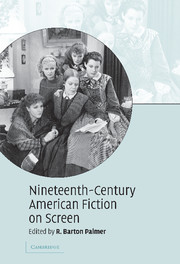Book contents
- Frontmatter
- Contents
- List of illustrations
- Notes on contributors
- Acknowledgments
- Introduction
- 1 A very American fable: the making of a Mohicans adaptation
- 2 Romancing the letter: screening a Hawthorne classic
- 3 The movies in the Rue Morgue: adapting Edgar Allan Poe for the screen
- 4 Readapting Uncle Tom's Cabin
- 5 Screening authorship: Little Women on screen 1933–1994
- 6 Melville's Moby-Dick and Hollywood
- 7 Screening male sentimental power in Ben-Hur
- 8 John Huston's The Red Badge of Courage
- 9 Translating Daisy Miller
- 10 Jane Campion's The Portrait of a Lady
- 11 The Europeans – and the Americans
- 12 Sister Carrie becomes Carrie
- 13 Hollywood and The Sea-Wolf
- 14 An untypical typicality: screening Owen Wister's The Virginian
- Filmography
- Index
10 - Jane Campion's The Portrait of a Lady
Published online by Cambridge University Press: 22 December 2009
- Frontmatter
- Contents
- List of illustrations
- Notes on contributors
- Acknowledgments
- Introduction
- 1 A very American fable: the making of a Mohicans adaptation
- 2 Romancing the letter: screening a Hawthorne classic
- 3 The movies in the Rue Morgue: adapting Edgar Allan Poe for the screen
- 4 Readapting Uncle Tom's Cabin
- 5 Screening authorship: Little Women on screen 1933–1994
- 6 Melville's Moby-Dick and Hollywood
- 7 Screening male sentimental power in Ben-Hur
- 8 John Huston's The Red Badge of Courage
- 9 Translating Daisy Miller
- 10 Jane Campion's The Portrait of a Lady
- 11 The Europeans – and the Americans
- 12 Sister Carrie becomes Carrie
- 13 Hollywood and The Sea-Wolf
- 14 An untypical typicality: screening Owen Wister's The Virginian
- Filmography
- Index
Summary
Henrietta's granddaughter
In 1996 Jane Campion's The Portrait of a Lady opened to negative responses, though Campion's star was high because of The Piano's 1993 success. Portrait features Nicole Kidman as Isabel Archer, supported by John Malkovich, Viggo Mortensen, and Sir John Gielgud, among others. Kidman could carry a film now; then she was neither a star nor a respected actor. Malkovich was a respected actor associated with manipulative parts such as his role of Gilbert Osmond in Portrait. However well-regarded, the rest of Portrait's cast were moving modestly either up or down the stairway to stardom – with the exceptions of Gielgud, whose part is limited, and Mortensen, whose Aragorn was not yet a gleam in Peter Jackson's eye. Inevitably, Portrait was marketed as “a film by Jane Campion,” “the director of The Piano.”
So we begin by asserting The Portrait of a Lady as a director's film, the work of an auteur. Auteur films manifest an artistic personality through theme, style, or both; Campion's films prove the concept's value. All her films have played with narrative structure, exhibited a distinctive visual and aural style, and explored power struggles within families and between men and women. Campion's auteurism makes her Portrait a work of art itself, rather than a poor relation of Henry James's original.
James's status as a great novelist is a given, but who is this New Zealand-born, Australian-trained woman to make a film of one of his greatest novels? It is as if Henrietta Stackpole's granddaughter had set out to tell the story from her point of view.
- Type
- Chapter
- Information
- Nineteenth-Century American Fiction on Screen , pp. 161 - 174Publisher: Cambridge University PressPrint publication year: 2007



